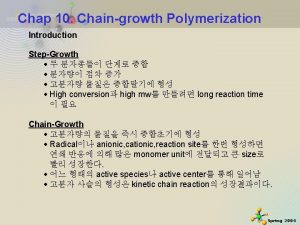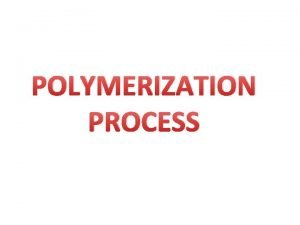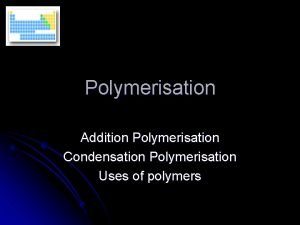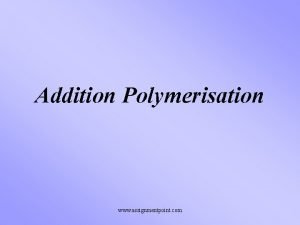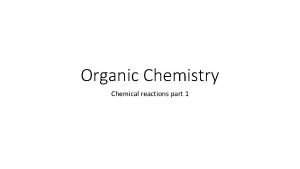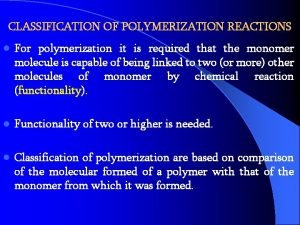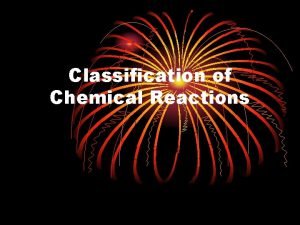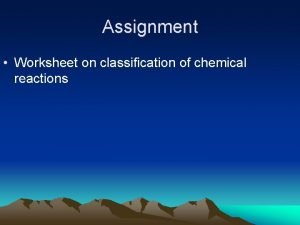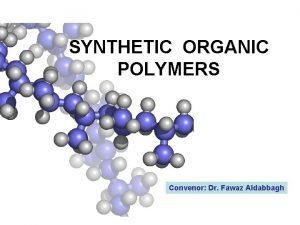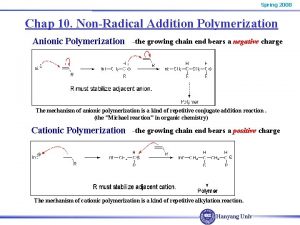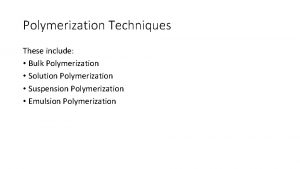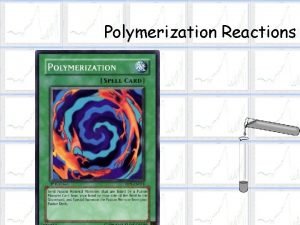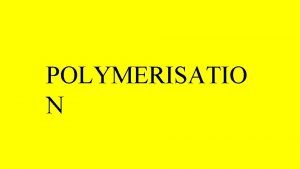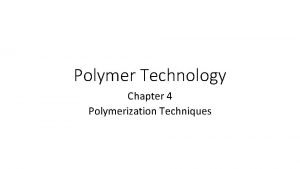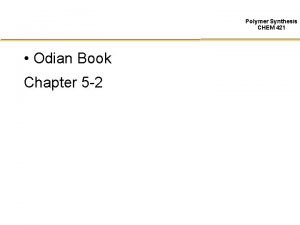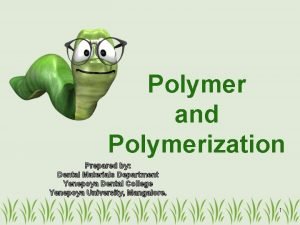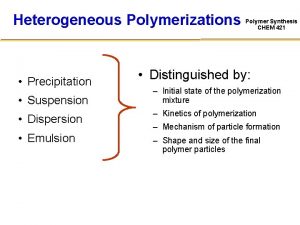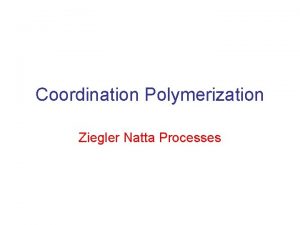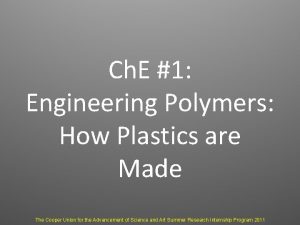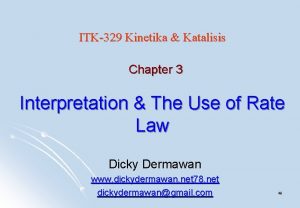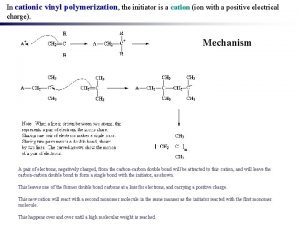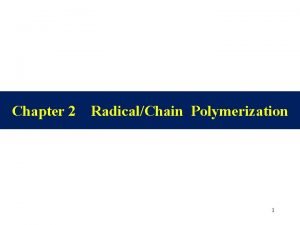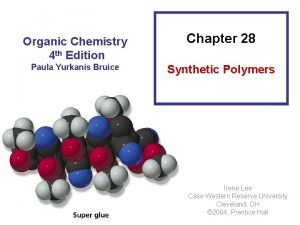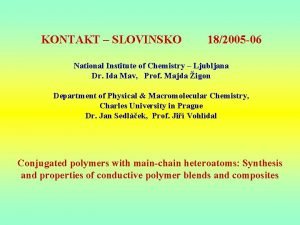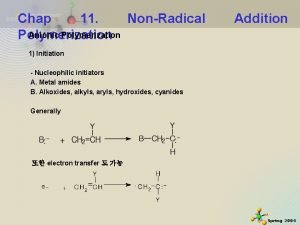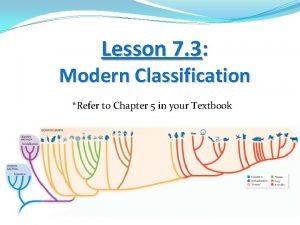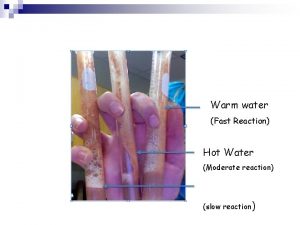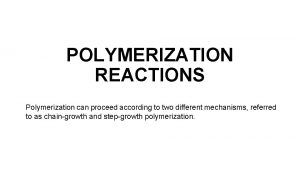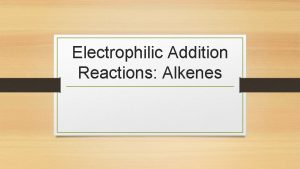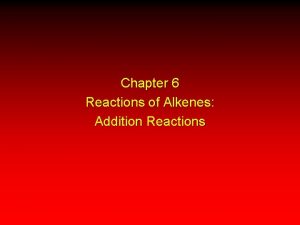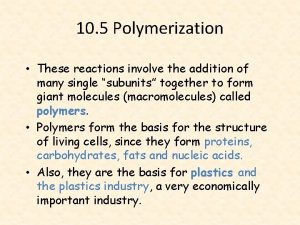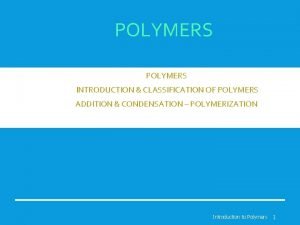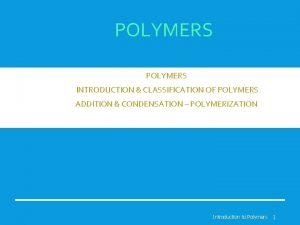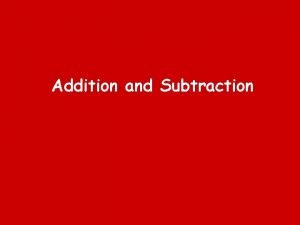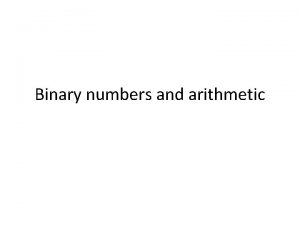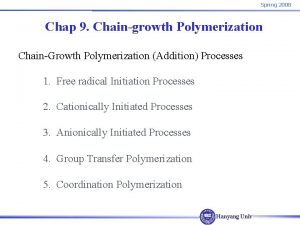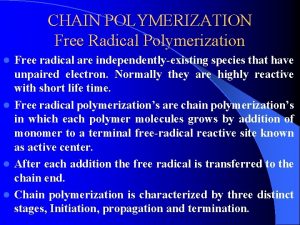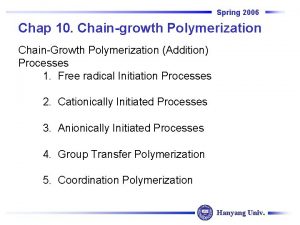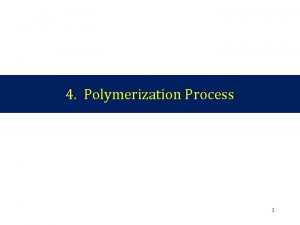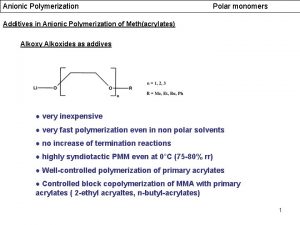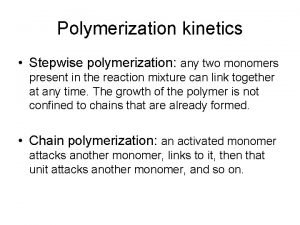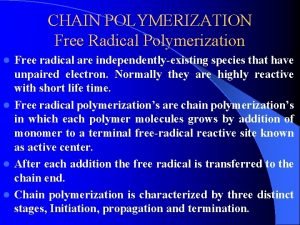Week 05 Classification of Polymerization Reactions Addition Polymerization






















![Zeigler-Nata catalysts § Triethyl aluminium [Al(R)3] act as the electron acceptor whereas the electron Zeigler-Nata catalysts § Triethyl aluminium [Al(R)3] act as the electron acceptor whereas the electron](https://slidetodoc.com/presentation_image_h2/99950543c9b3d9294d79d041a293d9a7/image-23.jpg)














- Slides: 37

Week # 05 Classification of Polymerization Reactions – Addition Polymerization Polymer Science and Engineering (TM-2052) By: Muhammad Haseeb Iqbal National Textile University

Concepts to be covered in this week What is addition polymerization and steps involved in reaction § Different mechanisms of addition polymerization like § § § free radical polymerization ionic polymerization coordination polymerization and Ziegler Natta Polymerization

In polymer chemistry, ring-opening polymerization is a form of chain-growth polymerization, in which the terminal end of a polymer acts as a reactive centre, where further cyclic monomers join to form a larger polymer chain through ionic propagation

Addition Polymerization § § § In this type of polymerisation, the molecules of the same monomer or different monomers add together on a large scale to form a polymer The monomers normally employed in this type of polymerization contain a carbon-carbon double bond (unsaturated compounds, e. g. , alkenes and their derivatives) that can participate in a chain reaction A chain reaction consists of three stages § § § Initiation Propagation Termination

§ § In the Initiation step an initiator molecule is thermally decomposed or allowed to undergo a chemical reaction to generate “active species”. This "active species, " which can be a free radical or a cation or an anion, then initiates the polymerization by adding to the monomer's carbon-carbon double bond. The reaction occurs in such a manner that a new free radical or cation or anion is generated. The initial monomer becomes the first repeat unit in the incipient polymer chain.

§ § In the Propagation step, the newly generated "active species" adds to another monomer in the same manner as in the initiation step This procedure is repeated over and over again until the final step of the process, termination, occurs In the Termination step, the growing chain terminates through reaction with another growing chain, by reaction with another species in the polymerization mixture, or by the spontaneous decomposition of the active site Under certain conditions, anionic can be carried out without the termination step to generate so-called "living" polymers

General characteristics of addition polymerization Once initiation occurs, the polymer chain forms very quickly § The concentration of active species is very low. Hence, the polymerisation mixture consists of primarily of newly-formed polymer and unreacted monomer § Since the carbon-carbon double bonds in the monomers are, in effect, converted to two single carbon-carbon bonds in the polymer, so energy is released making the polymerization exothermic with cooling often required §

Types § The mechanism of addition polymerisation can be divided broadly into two main classes, • • Free radical polymerization Ionic polymerisation o Ionic polymerization was probably the earliest type to be noted, and is divided into o o cationic and anionic polymerizations

Free radical polymerization A variety of alkenes or dienes and their derivatives are polymerized in the presence of a free radical generating initiator (catalyst) like benzoyl peroxide, acetyl peroxide, tert-butyl peroxide, etc. § A free radical may be defined as an intermediate compound containing an odd number of electrons, but which do not carry an electric charge and are not free ions § For example, the polymerization of ethene to polythene consists of heating or exposing to light a mixture of ethene with a small amount of benzoyl peroxide initiator §

Free radical polymerization § The first stage of the chain reaction is the initiation process; this process starts with the addition of phenyl free radical formed by the peroxide to the ethene double bond thus generating a new and larger free radical

Free radical polymerization The second stage of the chain reaction is the propagation process, the radical reacts with another molecule of ethene, and another bigger sized radical is formed § The repetition of this sequence with new and bigger radicals carries the reaction forward and the step is chain propagating step §

Free radical polymerization • The final stage of the chain reaction is the termination process; the product radical formed reacts with another radical to form the polymerized product


Ionic Polymerisation The addition polymerization that takes place due to ionic intermediate is called ionic polymerization § Based on the nature of ions used for the initiation process ionic polymerization classified into two types; § • • Cationic polymerization Anionic polymerization

Cationic polymerization depends on the use of cationic initiators which include reagents capable of providing positive ions or H+ ions. § Typical examples are aluminum chloride with water (Al. Cl 3+H 2 O) or boron trifluoride with water (BF 3+H 2 O) § They are effective with monomers containing electron releasing (nucleophilic) groups like methyl (−CH 3) or phenyl (−C 6 H 5) etc. § They include propylene (CH 3−CH=CH 2) and the styrene (C 6 H 5−CH=CH 2) §

Cationic Polymerization Chain Initiation: Decomposition of the initiator is shown as BF 3 + H 2 O→H+ + BF 3(OH–) § The proton (H+) adds to C – C double bond of alkene to form stable carbocation §

Cationic polymerization § Chain Propagation: Carbocation add to the C – C double bond of another monomer molecule to from new carbocation

Anionic polymerization depends on the use of anionic initiators which include reagents capable of providing negative ions § Typical catalysts include sodium in liquid ammonia, alkali metal alkyls, Grignard reagents and triphenylmethyl sodium [(C 6 H 5)3 C-Na] § They are effective with monomers containing electron withdrawing groups like nitrile (–CN) or chloride (-Cl), etc § They include acrylonitrile [CH 2=C(CN)], vinyl chloride [CH 2=C(Cl)], methyl methacrylate [CH 2=C(CH 3)COOCH 3], etc §

Anionic polymerization Chain Initiation: Butyl lithium (C 4 H 9 Li) adds to C – C double bond of alkene to form stable carbanion § Chain Propagation: Carbanion adds to the C – C double of another monomer molecule to from new carbanion § Chain Termination: Termination takes places only after addition of terminating agent (substances that are able to accept electrons water, carbon oxide, alcohols, ethylene oxide and others) §


Coordination polymerization It is also a subclass of addition polymerization § It usually involve transition-metal catalysts § Here, the "active species" is a coordination complex, which initiates the polymerization by adding to the monomer’s carbon-carbon double bond § The most important catalyst for coordination polymerization is socalled Ziegler-Natta catalyst discovered to be effective for alkene polymerization §

Ziegler-Natta catalysts combine transition-metal compounds such as chlorides of titanium with organometallic compounds [Ti. Cl 3 with Al(C 2 H 5)3] § An important property of these catalysts is that they yield stereoregular polymers when higher alkenes are polymerized, e. g. , polymerization of propene produces polypropene with high selectivity § Branching will not occur through this mechanism since no radicals are involved; the active site of the growing chain is the carbon atom directly bonded to the metal §
![ZeiglerNata catalysts Triethyl aluminium AlR3 act as the electron acceptor whereas the electron Zeigler-Nata catalysts § Triethyl aluminium [Al(R)3] act as the electron acceptor whereas the electron](https://slidetodoc.com/presentation_image_h2/99950543c9b3d9294d79d041a293d9a7/image-23.jpg)
Zeigler-Nata catalysts § Triethyl aluminium [Al(R)3] act as the electron acceptor whereas the electron donor is titanium halides and the combination, therefore, readily forms coordination complexes § The complex formed, now acts as the active centre


Condensation Polymerization § § § This type of polymerisation generally involves a repetitive condensation reaction (two molecules join together, resulting loss of small molecules) between two bi-functional monomers These polycondensation reactions may result in the loss of some simple molecules as water, alcohol, etc. , and lead to the formation of high molecular mass condensation polymers. In these reactions, the product of each step is again a bi-functional species and the sequence of condensation goes on Since, each step produces a distinct functionalised species and is independent of each other; this process is also called as step growth polymerisation The type of end polymer product resulting from a condensation polymerization is dependent on the number of functional end groups of the monomer which can react

§ § Monomers with only one reactive group terminate a growing chain and thus give end products with a lower molecular weight Linear polymers are created using monomers with two reactive end groups and monomers with more than two end groups give three dimensional polymers which are cross linked. Polyester is created through ester linkages between monomers, which involve the functional groups carboxyl and hydroxyl (an organic acid an alcohol monomer) The formation of polyester like terylene or dacron by the interaction of ethylene glycol and terephthalic acid is an example of this type of polymerisation

Polyamide is created through amide linkages between monomers, which involve the functional groups carboxyl and amine (an organic acid an amine monomer) § Nylon-6 is an example which can be manufactured by the condensation polymerisation of hexamethylenediamine with adipic acid under high pressure and at high temperature. §

The free carboxyl or hydroxyl group of the resulting dimer can then react with an appropriate functional group in another monomer or dimer, this process is repeated throughout the polymerization mixture until all of the monomers are converted to low molecular weight species, such as dimers, trimers, tetramers, etc. § These molecules, which are called oligomers, can then further react with each other through their free functional groups § Polymer chains that have moderate molecular weight can he built in this manner. §

General characteristics of condensation polymerization The polymer chain forms slowly, sometimes requiring several hours to several days § All of the monomers are quickly converted to oligomers, thus, the concentration of growing chains is high § Since most of the chemical reactions employed have relatively high energies of activation, the polymerization mixture is usually heated to high temperatures § Step-reaction polymerizations normally afford polymers with moderate molecular weights, i. e. , <100, 000 § Branching or cross linking does not occur unless a monomer with three or more functional groups is used §


Comparison between addition and condensation polymerization Addition polymerization Condensation polymerization Monomers are unsaturated Monomers contain two or more functional groups Nothing is eliminated as a result of reaction Small molecules like H 2 O, CH 3 OH, HCl etc. are eliminated High molecular weight is attained at once High molecular weight is attained only at very high conversions Only monomers and polymers are present during the course of polymerization All molecular weight species viz. dimers, trimers, tetramers and multimers etc. are present Chain grows at active centres Stepwise intermolecular condensation Polymer molecular weight is equal to DP× molecular weight of polymer Not so, some small molecules often eliminated Involve opening of double bond by active species like free radical or ion. Involve reaction between functional groups

Comparison between addition and condensation polymerization Addition polymerization Condensation polymerization Example polymers are polyolefins, polydienes, vinyl polymers and acrylic polymers Examples are polyesters, polyamides and polycarbonates Catalyst generates active species that attack monomer Uncatalysed or catalysed (e. g. by acids) processes are possible The process of polymerization is exothermic Most reactions have high activation energy and hence usually heating is required Can be done by bulk, solution, suspension and emulsion polymerization techniques Polycondensation can be achieved in melting, solution as well as at interfacial boundary between two liquids Can quickly lead to a polymer with high molecular weight, crosslinking can be achieved by using monomers with two double bonds e. g. divinylbenzene Slow stepwise addition process, molecular weight is <1, 000, Highly dependent on monomer stoichiometry. Little amount of tri or multifunctional monomers develops extensive crosslinks

Addition Polymerization

Condensation Polymerization

Step growth polymerization (Polyaddition) § The Diels-Alder condensation of a bisdieneand benzoquinone forms an addition polymer, i. e. , one possessing only carbon atoms in its backbone and where no byproductis produced. Yet the polymer is formed through a stepwise kinetic process.

Other Examples § Internal esters (lactones) are readily polymerized by chain wise, acid-catalyzed ring openings without expulsion of a by product, yet the resulting polyester is a condensation polymer exhibiting a heteroatomed polymeric backbone. Furthermore, the six-carbon polyester is also formed using typical stepwise polycondensation of hydroxycarboxylic acid

Thank You Best of Luck!
 Trommsdorff effect
Trommsdorff effect Bulk polymerization
Bulk polymerization Addition polymerisation
Addition polymerisation Addition polymerization
Addition polymerization But-2-ene polymer
But-2-ene polymer Chemical reactions section 2 classifying chemical reactions
Chemical reactions section 2 classifying chemical reactions Redox reaction example
Redox reaction example Section 2 classifying chemical reactions
Section 2 classifying chemical reactions Chemical reactions section 3 reactions in aqueous solutions
Chemical reactions section 3 reactions in aqueous solutions Unit 5 chemical reactions answers
Unit 5 chemical reactions answers Classification of polymerization
Classification of polymerization Week by week plans for documenting children's development
Week by week plans for documenting children's development Chemical reactions classification
Chemical reactions classification Classification of chemical reactions worksheet
Classification of chemical reactions worksheet Fawaz aldabbagh
Fawaz aldabbagh Anionic polymerization mechanism
Anionic polymerization mechanism Solution polymerization
Solution polymerization What is polymerization
What is polymerization Polymerisatio
Polymerisatio Types of polymerization
Types of polymerization Chem
Chem Polymer in dentistry
Polymer in dentistry Step growth polymerization vs chain growth
Step growth polymerization vs chain growth Suspension polymerization
Suspension polymerization Ziegler-natta coordination polymerization
Ziegler-natta coordination polymerization Nika sabasteanski
Nika sabasteanski In a homogeneous isothermal liquid polymerization 20
In a homogeneous isothermal liquid polymerization 20 Cationic vinyl polymerization
Cationic vinyl polymerization Polymerization
Polymerization Polymerization
Polymerization Polymerization isomerism
Polymerization isomerism Polymerization sedlacek
Polymerization sedlacek Polymerizability
Polymerizability Eager learning algorithm example
Eager learning algorithm example Semi-tabulation presentation
Semi-tabulation presentation Traditional classification vs modern classification
Traditional classification vs modern classification Fast reactions
Fast reactions Stoichiometry island diagram
Stoichiometry island diagram
